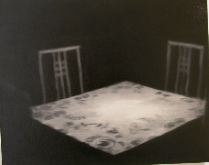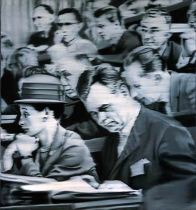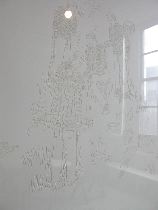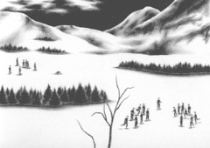
Was it me or was there an unusual amount of energy in the air in February, a time normally devoted to burrowing and dreaming about beaches. I’m not only talking about The Gates and Dali, the two blockbuster high energy events. But in the local galleries, too, there was much going on. Libby told you about the shows at the Gallery Xes here and here and I want to do a quickie on them before moving into the March landscape because they were both so good.
hu, joseph
Vox Populi
Joseph Hu‘s grisaille paintings of an apartment sans occupants seemed, because of their horizontal striations, to be floating sideways. The works were like visions from a dream state. Everything seemed underwater, or like a trance-induced vision. Desire and hurt lie on these works which are not about happy memories but about the ones that, like toothaches, are painful and demand constant attention.

richter, gerhard
The clear reference to Gerhard Richter‘s grisaille paintings (shown, “Der Kongress”) and to Hiroshi Sugimoto‘s blurry black and white photographs of iconic buildings like the Empire State Building made these works reverberate with — if not politics, then the sociology of people and the times and places that shape them. The title, “It takes a Candle when it goes to the Cellar” (top image) for the painting that seemed to me the most beautiful and eerie, had echoes to the movie “Silence of the Lambs” in which a serial killer dehumanizes his female victims by calling them “it.”
“Silence of the Lambs” probably has nothing at all to do with the work but my flashing on that cinematic reference had the effect of turning the entire installation into a kind of painted crime scene.

witte, justin
Around the corner from Hu were Justin Witte‘s blindingly white puff paint works which scored on the hurt the eye scale as well as the break the camera scale.
These works, which I loved, demanded so much of a viewer that they seemed to go beyond anything I’ve experienced in the realm of paint in Philadelphia. (image is my feeble attempt to catch a snap of one. I caught the window reflection pretty well but not the the Witte.)

o’neil, robyn
Witte’s imagery, what you can see of it, is loveable. What I thought I saw resembled a combination of Paul Noble‘s fantasy architecture of decay with Robyn O’Neil‘s mystery guys tramping around in the snow and performing rituals. The package is fanciful and endearing. (image is O’Neil‘s drawing “The Pre-Conference with an Unfair Fight in the Back.” O’Neil, who was in the 2004 Whitney Biennial also showed with Gallery Joe in the “Figure Out” exhibit. See post.)
I understand why Witte uses white on white but, after wrangling with the works for what seemed like quite a while (it probably was in the neighborhood of 15-20 minutes) I felt a little defeated. I love Witte’s paintings when viewed through my mind’s eye in memory. But face to face the works made my eyes hurt and all in all I’d rather see an image than know it’s there and not see it. I look forward to Witte’s next phase, may he bring back a little color, please.

abrams, stefan
A word about Stefan Abrams‘ project “stefan.jpg.” (image is detail of the array of pictures that came up in the artist’s image search for stefan.jpg) I love that artists are playing with Google and other search engines and creating art that reflects what is going on in cyber space. It’s important for artists to consider the web just another tool in the box. I’m going to consider Abrams’ piece first generation image search art and look forward to what comes next. Like the work of Kenneth Jones, recently at the Print Center, who made color prints of his computer screen that look like they were from the “Grabber”program, the work needs to be less in thrall to the technology.
Nexus

mccloskey, tom
In the front space, the wonderful Missioncreep exhibit crackled with good spirits, cameraderie and great art. It was wonderful to see this cyber-venue come into the real world for a celebration of its art and writing.
And in the back space, Tom McCloskey‘s sculpture/video installation was smart and memorable. I talked with the artist at Nexus last week.
I’d seen McCloskey’s pieces (a drawing and a video sculpture) in the “Discontent” exhibit and thought they were standouts (see post). I wanted to know more about where the work, which has politics and social commentary in it, came from — and where it might be going. (image is of the sleeping shooters who wake every ten minutes when a gunshot sounds)
The artist, who’s from Philadelphia, graduated from PAFA and that is a shock since the work is, in my opinion, un-PAFA like. McCloskey told me that PAFA faculty Jody Pinto and Robert Roesch, both sculptors and both freely non-Academy in their own work, were instrumental in helping him produce in the Academy but not in the Academy style. So he’s a sculpture guy. As for the video, McCloskey told me that he is a self-taught video artist. He got his hands on a video camera his in-laws bought when they thought they’d videotape their daughter’s wedding. The in-laws never did figure out how to use the camera and the wedding went untaped but McCloskey wound up with the equipment and was hooked.
The artist had a video piece in the travelling “Illegal Art” exhibit which ran at Nexus some time back. (See post). When he heard they were seeking members he applied. In his day job, the artist is a house painter, a job that allows him flexibility to take off when he needs to to put an exhibit together.
McCloskey said he is interested in the theater. He loves the lights, the sets, the over-the-top dramatic moments. He was thinking theater when he put his Nexus installation together. And indeed the three pieces feel like three stages or three acts of an absurdist comedy. With no words but lots of sound (a gun shot and growling voices which proceed at what seem like random intervals) the works convey the circus of life absent the ring master. It’s a jungle.

The artist, who said he spends a lot of creative time at Best Buy eyeballing monitors of this size and that, learned to sew on a machine recently. He stitched all the soft sculptural elements himself. And when I asked what was next, the artist told me that he wanted to spend time drawing, something he likes to do daily. “It all starts with drawing…that’s where the ideas come,” he said. McCloskey made comic books as a child. Even today his favorite drawing materials are a “Uniball pen from Staples, a pencil and cheap watercolors.” (image is detail of “Lost Worm”)
McCloskey’s thoughts are on society always. He spends time each week with a friend, Andrew Schwalm, who’s an anthropologist (Schwalm is one of the growling faces in McCloskey’s chair piece). They talk about the world, about culture, and about life’s big picture. I can’t wait to see what comes next.
Finally, it’s interesting to me how particular young artists make their way to the city’s two main alternative co-op galleries, the Gallery Xes — Vox and Nexus. I always wondered who went with which gallery and why. I imagine the reasons have to do with friendship networks or more ephemeral things (like the jurying in process which would trigger the “birds of a feather” effect). Whatever the reason, the art coming out of the two Gallery Xes, which is similar — but not the same — is in a nice, strong forward-looking 21st Century orbit.









